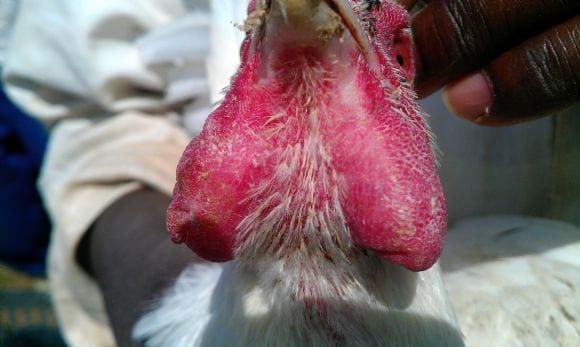Swollen wattles in broiler breeders
Forum: Swollen Wattles
What are the most important causes of swollen wattles in broiler breeders?

We have seen similar swollen wattles, in a case of infectious Coriza in layer hens. It was the first time
Haemophilus paragallinarum isolation in Bolivia. At first we suspect of pasterella multocida, but that was not de case.
I have seen swollen wattles in turkeys flocks in cases where Pasterella multocida and E. coli were isolated from wattles tissue. I suppose that prevalence of such cases increase when you do wide-spread antibiotic metaphylaxis

I would like to thank Dr. Moganziwa, Dr. Rodko and Rolon. I would like to know about the flock, and what is the % of cases if this occurs in a house or more, the epidemiology and the last vaccination. Perhaps there are not serious cases and it´s not transmitted to other farms.
Thanks to all I would like to know about the post mortem lesions and vaccination of fowl cholera on this flock.
Pasturella maltocida the most common cause of swollen wattles but other diseases may cause swollen wattles the only is to open the lesions and see how do they look and do a culture and sensetivity of the sample. You also need to know the popualtion that is affected how old is the flock the vaccination status and production status if they are parents. Do have any mortalities from the flock if there what percent.


Effective Solutions to Manage Poultry Heat Stress for Better Health and Farm Productivity
Hi Dr. Shadreck, I have seen this with our Breeder flocks here in Fiji. We have Cobb breed. There are a few questions you need to answer for diagnosis.
1. Any discharge from the eyes, nostril, wattle?
2. What age?
3. Type of male feeders? if you have tube feders for males which swing around when males try to feed off it will cause mechanical damage and oedema of the wattles.
4. Is the any increase in female mortality? Where are they found if any?
5. Any changes in production?
6. What is your Rodent control program like?
7. Any postmortem changes seen?
In our case we isloted it to Fowl Cholera (Pasturella multocida). It was spread by field mice. Adjustments we made:
1.We had nest racks that were not raised and harboured huge numbers of mice in the sheds. So we raised all nest racks for the birds to have move under the racks.
2. Stopped all spillage of feed in the sheds especially from the feeder tracks.
3. Reduced the amount of floor shavings to prevent burrowing of the mice.
4. Blocked all potential points of entry for the mice. We have this problem only when there is the sugarcane harvesting season.
5. Checked and removed all nest boxes for any mice colonies.
Treating your flocks with OTC @ 60mg/kg for 10 days works.
It appears to be a male birds with both wattles swollen. Swelling has passed the acute phase. Such lesions are highly suggestive of Chronic Fowl Cholera. However, local injuries due to male fighting and infected with pyogenic bacteria needs to be excluded.
I have also seen acute swelling of wattles in Avian Influenza (AI) but with high mortality (Chronic cholera cases are usually sporadic).
It might be Pasturella multocida or Fowl Cholera associated with some others Gram+ve and Gram-ve bacteria
First of all I would like to extend my sincere gratitude to all vets all around. Despite all participations and thoughts from dear vets, I would like to remind all of u that the isolation and identification of the causative agent is the rule of thumb.
No doubt it is Fowl cholera, it has to be differentiated from other bacteria through cultural examination as opined by other Vet Doctors. Photograph is good.
In Fowl Cholera the mortality rate is high. If you face high morbidity and low morality plus nasal and lacrimal discharge (one or both side), reduce egg production without change in quality (in case of production phase), low feed and water consumption, 10 to 15 days course, low common period (2D), positive response to antibiotics, exudate in trachea (usu non fibrionopurrolant), with or without Avibacterium paragallinarum bacterin vaccine, maybe gasping in male: strogly yoy faces Infectious Coryza.
Iran.


Bacillus amyloliquefaciens CECT 5940 (Ecobiol®) alone or in combination with antibiotic growth promoters improve performance in broilers under enteric pathogen challenge
Hamid Reza Fallah
Thank you for providing me valuable information.
With regards
Bidhan
Here in Bangladesh, Fowl Cholera is a very common disease in commercial layer, But only swollen wattle is not enough sign to diagnose any disease.
So it is my humble request to all respective person to describe the proper history and clinical sign.
Thanks.


























